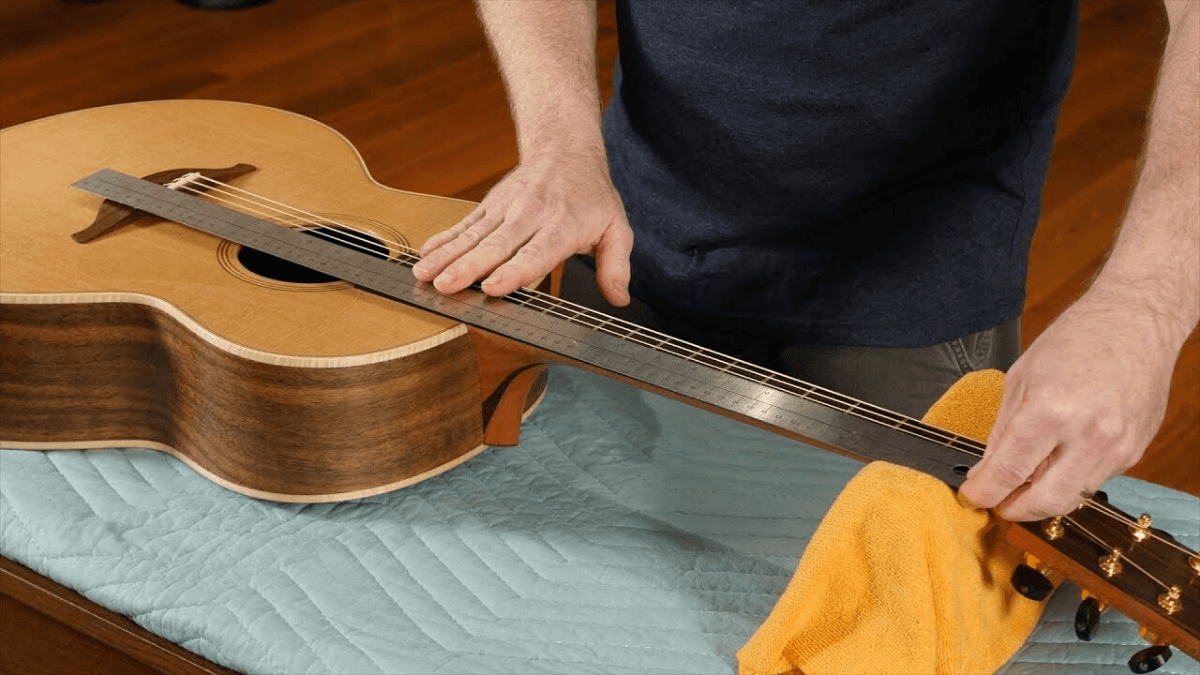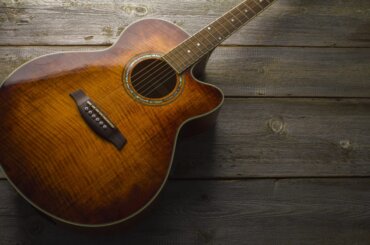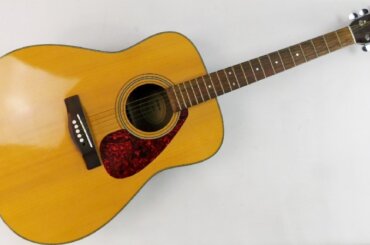If seen from one perspective, music is nothing else but pure mathematics. From a different perspective, music is a language that speaks out emotions. Both of these perspectives hold true from time to time. If music is nothing else but pure mathematics, the musical instruments should also have a strong involvement in mathematics, isn’t it? To measure a guitar is more than just measuring the total length and scale length.
The guitar is one of the finest string instruments popular worldwide. One of the reasons why it delivers what it does is the precision that is involved in its construction. Deconstructing a guitar leads us to its parts. A Guitar consists:
- Neck
- Fretboard
- Body
- Strings
- Bridge
All of these have their own mathematics. Based on this, these deliver the type of sound that you get to hear while listening to them. Each of the parts has its own measurements. It is the job of the manufacturing team to construct an electric guitar in a different measurement than an acoustic. An acoustic guitar with a different measurement than a bass guitar.
This guide provides its reader with an understanding of how to measure one’s guitar and its parts. Also, it enlightens the readers about the effect of every part with the overall sound quality of the guitar. First things first, let’s provide you with the answer to the question.
How to Measure a Guitar in General?
The general measurement of guitar means the overall length and scale length of the guitar.
Total Length
To know the entire length of a Guitar, one has got to determine the space between the headstock of his/her guitar and the bottom of the body. As shown within the figure below:
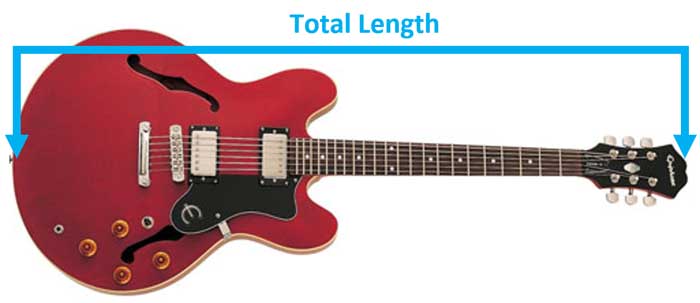
Take a tape for the measurement of a guitar and line it up along the strings. the entire length is from the very end of the body to the tip of the headstock. You must have noticed that each sort of guitar features a differently shaped body. For this reason, you’ll see wildly different measurements for total length. the entire length of a ‘full size’ guitar might be anywhere from 36 inches to overflow 40 inches.
There’s no standard total length for guitar because there are many various sorts of options out there. The entire length of a guitar isn’t the correct method for comparing guitars. Some brands have long headstocks, while other brands have short headstocks. The dimensions of a headstock don’t make a guitar feel any different once you play it, but differences in headstocks will throw off measurements.
Scale Length
Generally, Guitars are compared using their scale lengths. This length is the most vital measure for a guitar because it impacts how a guitar feels once you play it. Even the slightest of the difference in scale length can feel completely irrelevant when playing. A guitar’s scale length is measured from the bridge of the guitar to the guitar’s nut as shown within the below diagram:
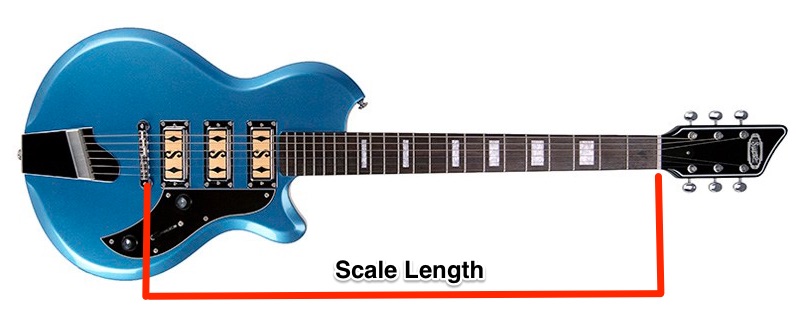
Another way to find out what a guitar’s scale length is, take the measure from the nut to the 12th fret then multiplying that by 2. I say ‘broadly’ as, if you measure this, you will find each string’s measurement to be a touch longer than the particular scale length. This increased length helps the instrument to sound in tune everywhere the fingerboard—it’s called compensation or intonation and we’ll get into that another day. To accurately assess the size length of an instrument, you would like to check from the within of the nut to the center of the 12th fret. Once you’ve got this, double it. that is the scale length. So, if you measure your Strat, you will find a nut-to-12th-fret measurement of 12.75″. Doubling this provides us 25.5″. That’s our scale length.
What is Guitar’s Action and How to Measure it?
A guitar’s action is a measure of how high the strings are over the fretboard. Measuring a guitar’s action requires more precision than measuring the overall guitar length and scale length. So, you can use tape for measuring the overall length and a scale length of a guitar. In case of measuring the action of a guitar, use a Stew mac action edge. Measuring a guitar’s action is only one part of measuring a complete guitar setup. To measure a guitar’s complete setup is to include measurement of four parts of guitar:
- Neck straightness
- 12th fret action.
- Bridge saddle radius
- 1st fret action.
Measuring Neck Straightness of a Guitar
Starting from the head of the guitar, the neck is the first part when it comes to measuring a guitar. Set the neck of the guitar using one of the three ways:
- Back bow: The neck angle with straight-line is more than 180 degrees. This sort of arrangement should be avoided because it is less favorable to have in a guitar.
- Up bow: The neck angle with straight-line is less than 180 degrees. This sort of arrangement is also known as a relief.
- Straight lined: The neck angle with straight-line is exact 180 degrees.
Straight lined neck arrangement is popular among light touch professional players. Strummers that like playing chords heavily on a guitar prefer up bow neck. Because in up-bow there is a lot more room for strings to vibrate than in straight lines and back bow.
Neck straightness measurements happen by holding the guitar in the playing position and keeping a finger on the first string, first, fret and another finger on the first string last fret and then one needs to look the middle fret and check whether the string is up, back or just in line. Accordingly, the neck is determined to be a back bow, up the bow, or straight-lined.
Change the neck arrangement using a truss rod. However, while changing the neck position with a truss rod, one thing that should be kept in mind is to not keep the guitar down. Instead, keep the guitar in playing position so that even gravity cannot pull the strings down and your adjustment happens uninterrupted. Now that the first part’s description and adjustments are completed, let’s go to the other part that is important to know and adjust while knowing how to measure a guitar. After neck, comes the inner fret action. This is the second step to measure a guitar. You should notice, how by starting from the head, we went to the neck, and now we will go a little bit more inside to measure a guitar’s part.
Measuring 12th fret action
To measure action, make use of stew mac’s action gauge. A stew mac’s action gauge is a special instrument for measuring the small distance that makes up the action. The specialty of a stew mac’s action gauge is that it has also got the conversion table just at its back due to which, just after the measurement, it can be converted into inches and mm. The action measurement takes place by keeping the stew mac action gauge on the fretboard. One must take two different measurements. One from the lower E string and the other one from the higher E string.
Remember that action is the distance between the top of the fret and the bottom of the string. To change the action of any string all one needs to do is take the help of the key by putting it on the hole given near the bridge saddle and rotate it clockwise or anticlockwise according to the need. Whilst the action determines the playability of the guitar, the bridge saddle radius determines the resonance. The third part to measure a guitar is the bridge saddle radius.
Measuring Bridge Saddle Radius
Under string, radius gauges are something that not every player has. Only the ones that are professional guitar players and love to take care of your guitar and not depend on the repairer, has it. They are T in shape, just that the sleeping line over the standing is not straight, but curvy. A fingerboard radius is first measured using Stew mac cells that have a cut out for the strings because of which you can slide them over the board anywhere without taking any extra care of your strings. This instrument has to be put on the 12th fret and if any light is seen underneath, it means that this is not the correct radius. The definition of the right radius is that it doesn’t allow any light to pass through.
After finding the right radius of the fretboard with the Stew mac cells, you can take the same radius’ String radius gauges and put them underneath the strings. One by one you need to vibrate all the strings and the string that doesn’t buzz needs to come down by a certain amount of distance. After doing so, your Guitar bridge saddle radius is good to go. Before ending the list of parts, whose measurement is important while knowing how to measure a guitar, we need to bounce a little bit back because we are going to learn…
Measuring 1st Fret action
First fret action is measured by pressing the first string first fret and pressing another fret on the same string. That is how you realize how much the string has actually traveled as well as the effort you are going to need while playing it. Some players also like to keep a nut file and adjust the distance by themselves, but that is a really risky business and can lead to ruining an expensive guitar. The average good clearance from lower E string to a higher E string would measure approximately: 25 inches (E to A), 22 inches (A to D), 20 inches (D to G), 16 inches (G to B), 14 inches from (B to E).
After knowing the different technicalities that are to be taken care of while playing and making of guitar, now is the time to let you explore how different parts of the guitar and their measurements affect their overall sound of the guitar.
Neck’s Effect on Sound
The thicker the neck is, the brighter the guitar would sound. This is the rule when it comes to the relation of the neck with the overall tone of the guitar. Some people believe that it’s only the material that is used in the making of the guitar is what affects its tone, but it’s not so. The designing of guitar and the mathematics that is involved in designing of its parts affects its overall sound too.
Bridge’s Effect on Sound
Depending on the size of the bridge, its stiffness is determined. The stiffer a bridge is, the lesser it will vibrate, and the shorter will be the resonance of the overall sound of the guitar. It is not that the material of which the bridges are made is not at all responsible for the type of sound that is produced. They too contribute in combination with the size of the parts.
Fretboard’s Effect on Sound
A fretboard’s radius does affect the overall sound and it is not very difficult to understand this logic. One may simply look at the acoustic and electric guitar on one side and the bass guitar on the other. Bass guitar has a larger fret width than an acoustic or electric guitar. Though other factors contribute to the bassy voice of bass guitar, fret width is an important one.
Body’s Effect on Sound
Different guitars have different body and different bodies produce different sounds. In an acoustic guitar, different types of bracings are used to make sure that the sound travels differently according to the genre that the guitar is meant for. In electric guitar, the body shapes don’t have much impact if compared to acoustic guitars.
The Conclusion
Starting by explaining to you how a guitar’s overall length and scale length are calculated, this guide takes you into the technicalities of how important things such as guitar’s action, bridge saddle, and neck can be measured and adjusted. In short, how you can measure a guitar. In the end, the guide also tells you how different measurements of different parts of the guitar affect its overall tone. By writing this guide, an attempt has been made to cover the most important measurements related to guitar at a single place.

